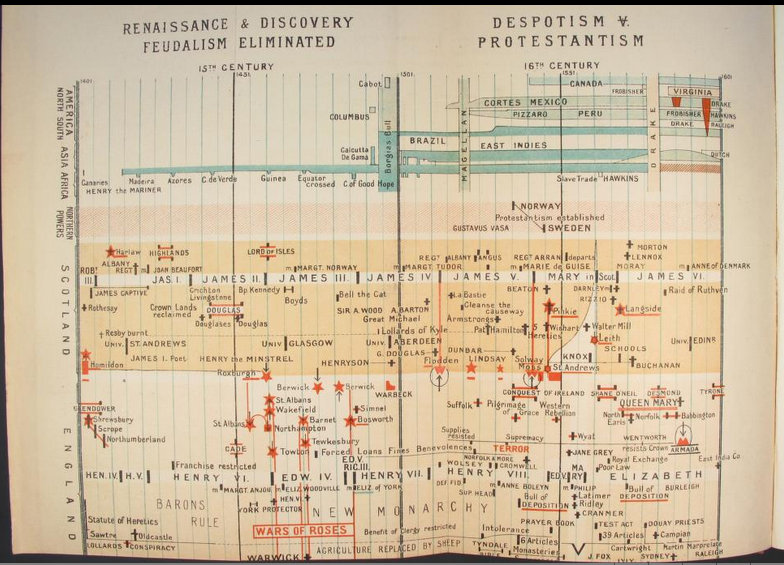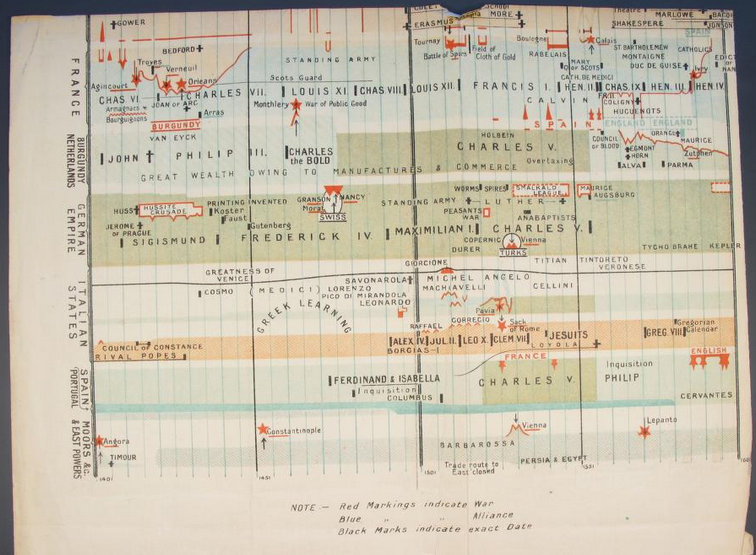

|
The Parents' ReviewA Monthly Magazine of Home-Training and Culture"Education is an atmosphere, a discipline, a life." ______________________________________ History: Teaching Practically Considered
STAGE III.--continued from Vol 4 pg 896 The fundamental principles which have guided us in the earlier stages of our teaching must still continue to guide us in this. In the earlier stages, our attention was exclusively occupied by those conspicuous personalities, those dramatic incidents, which history supplies most plentifully. These must still form a most important feature of our teaching. For around these, as indispensable nuclei, all our historic realizations must necessarily crystalize. It is not, however, in such incidents in themselves, but rather in the facts which underlie them, in the Hows and the Whys which they involve, that the deepest value of history is to be found. We may indeed look upon these dramatic occurrences as properly no more than the symptoms of those secular movements of change, those pathological processes, those evolutionary efforts of nature which are ever active in human society. Too often, indeed, we shall find in them only the blind attempt of political power to curb the benign and healing operation of the Time Spirit, which, in the endeavour to thwart they only serve the more effectually to reveal. For the purpose of our studies the facts of history may be conveniently, and at the same time logically, classified under five separate heads:-- 1. Geographic relations: the natural geographical divisions of the land; their diversities of natural conditions; the fundamental differences of race in the populations inhabiting these separate parts; geographic relations in regard to other lands. 2. Industry: the industries and occupations carried on in any land, and especially in primitive times, depend directly and fundamentally upon, and arise out of, the geographical conditions included under the previous head. 3. Social life: the social characteristics of the population in all its various sections--specially its family and general social customs. The social life may also be shewn to be the direct product of industrial conditions. 4. Religion,--which may be viewed as continuous with, but in some measure independent of social life. 5. Government, which arises logically out of the previous sections. Each separate fact of history will naturally group itself under one or more of these heads, and it is in the working together in harmony and complete adaptability of each of theses realms of human environment and activity, that the ideal condition of human existence can alone be found. The geographic conditions are to a large extent fixed, and at the same time largely govern the conditions of industry: though upon these geographic conditions the development of industry may again in a considerable degree react. Social conditions naturally arise from and consistently tend towards harmony with the industrial. There also exists constantly a strong tendency towards a just equilibrium in the realm of social life; but on the other hand changes in the industrial sphere have a constant contrary influence in the direction of instability and disharmony. Again, we must notice in the social sphere a strong influence of reaction upon the industrial. It is by social energies--by social, in their natural and close alliance with religious energies, that lies the main power of man for social amelioration. Government, with its remedies, comes upon us in retribution for our sins; with blind hands it gropes in the seething cauldron of humanity, and stirs from the depths, too often, worse evils than it attempts to allay. The end of government is through force to advance to liberty; it exists because of human imperfection, and like poverty, must be always with us. In concluding this topic it should be added that the great end of our historical studies should be ever before the mind of the teacher--our wiser social and political action. To return to what may be considered more practical considerations, the known and the familiar form the sole basis for the study of the unknown and the unfamiliar; it is thus obviously impossible for us to approach any of these threads of history from any other stand-point than that of our own surroundings; and our study of history must therefore consist in projecting backwards our knowledge of the present into the past, and searching there for the roots of the life we see around us. And in pursuing this course we are doubtless, at the same time, doing the best we can to produce a clear and luminous idea of that life of to-day, of its urgencies, it declensions and its upward tendencies, with all of which our individual activities are vitally concerned. For while it may be said that our knowledge of the past depends strictly upon our knowledge of the present, and of our immediate past experience, it will also equally hold true that our knowledge of the present can only be perfected by the light which is cast upon it by the study of the past. The teacher of history, therefore, keeping in mind the intimate relation between past and present, will at all times be ready in speaking of the present to illustrate it by comparison with the past; and, on the other hand, to illustrate the past by comparison with the present. It will, probably, somewhat facilitate our researches as to practical methods, at once to adopt a definite period of history as a concrete basis for our enquiry. We shall, therefore, select as our starting point, the reign of Henry VII. of England. The accompanying chart,* covering the history of the 15th and 16th centuries, has, as its centre of focal definition, the history of the British Isles, and is fitted to elucidate the historical movements brought into play during the Tudor regime, which the reign of King Henry VII inaugurates. (In preparing the accompanying chart, advantage has been taken of Historical Charts, kindly lent by Professor Patrick Geddes.)   * You can also view (and enlarge) this chart at archive.org. This chart is not intended to represent in its form or in its details, exactly what a schoolroom chart should be. The requirements of a schoolroom chart should fulfil must necessarily vary according to the use the chart is intended to serve. Thus, the chart may serve for use in the hand, or, again, at a distance for class demonstration. Doubtless, the ideal plan would be to have a chart on a large scale stretched on the schoolroom wall, and where this can be done, it should be preferred to every other form. But such a chart is not always possible; and even so, it has its insufficiencies. In the first place, if there is only room for one such chart it should obviously be reserved for a general chart of universal history in which it would be impossible, save on a very large scale, to go into much detail. But the special drawback connected with such a chart will be found in the difficulty in the way of the pupils working upon it with their own hands. This deficiency might perhaps be best supplied by the pupils working out each his own sectional chart for his own private use. It is decidedly to be desired that the chart should be built up gradually, and that only facts--definite facts--and not generalisations should, at least in the outset, be entered upon it. It is upon facts that history is based, and it is useless, perhaps almost a betrayal, to supply to our pupils generalisations ready made. It is first in the collection and classification of facts that the pupils can be led to actively participate in the history lesson, and in the simple process will be found the beginning of the further process of generalisation, which must be wrought out by leading the pupils, after classifying the events, to compare and observe similarities and differences in the events themselves each with each; after that to examine and compare the cause of the events; and then to compare with the phenomena of preceding periods and of the present day. In order to fix our chronology in a manner both exact and easily memorable, our first step will be to set down upon the chart the chain of English kings with the dates of their accession, and, as we proceed, to commit them to memory. The kings of Scotland, France, and latterly Spain, and several of the Popes should also be noted. Next we shall arrange and set down the political events during the reign of Henry VII.,-- for England: Bosworth, marriage of Elizabeth of York, Simnel, Warbeck, Benevolences &c., decay of Barons and Parliament. But already we shall have seen the necessity for setting down anterior events, and we shall add: Wars of Roses, Edward IV., Richard III., and taking all necessary facts for Scotland: "Bell the Cat," James III.'s death at Sauchieburn (note that the Wars of the Roses imply external peace for Scotland), marriage of Margaret Tudor; for France: Louis XI., War of Public Good, Scots Guard, Standing Army, royal authority consolidated; Spain: consolidation under Ferdinand and Isabella, expulsion of Moors, French-Spanish-Papal-Venetian wars in Italy, the Borgias, Medici, Machiavelli; Constantinople taken by the Turks. Next we shall note the Religious, Social, Industrial facts: Lollards in England onwards to Henry VII. (instances), Lollards in Scotland, Huss, Savonarola, corruption of Papacy, of clergy generally (instances during Henry VII.'s reign), benefit of clergy restricted, Inquisition in Spain; Renaissance, Greek learning in Italy (consequence of Turkish conquests), Erasmus, Colet, perfection of Tuscan art, literature flourishes in Scotland (result of long peace ?), printing invented; wealth of Netherlands, Florence, greatness of Venice, finest wool exported from England to these countries and to Spain, political regulation and protection of trade, royal revenue derived largely from trade, disappearance of serfage (14th century), scarcity of agricultural labour, substitution of sheep for agricultural production, vagrancy; discoveries beginning with Henry the Mariner (Portugal), Pope Alexander Borgia's Bull. Geographical facts: central position of London, first as regards England (vide physical map), risings occur at points most inaccessible; Netherlands' central for North Europe, Venice central for South Europe and East. Portugal near to Africa; Spain and Portugal maritime powers of the Atlantic. Italy lacks means of communication between her provinces. The under-noted books may be mentioned as useful in supplementing the ordinary manuals. Original records, of which [John Richard] Green's and other histories supply a list, are very valuable for illustration; to these may be added for Scotland, the quaint and graphic history [The Historie and Cronicles of Scotland] by Lindsay of Pitscottie; judicious extracts from these will prove both useful and interesting. Labberton's Historical Atlas (Macmillan, 15/-), with many historical maps, furnishes also useful sectional sketches of European history. Knight's Pictorial History of England a large work in seven volumes is most useful, first because of the numerous pictorial illustrations from contemporary sources, and also because of its devoting separate sections to social, religious and industrial facts. It also gives numerous quotations from contemporary documents and records. This book appears to be out of print, but may, without difficulty, be procured second-hand and at a moderate price. Both of the above-mentioned books are of great value. As further illustration, poetry is exceedingly useful; for the present period, however, England is poor in literature. In Scotland, [Robert] Henryson, and later, [Sir David] Lindsay supply useful illustrations. Typed by AniElizabeth, July 2018; Proofread by LNL, May 2021  |
| Top | Copyright © 2002-2021 AmblesideOnline. All rights reserved. Use of these resources subject to the terms of our License Agreement. | Home |